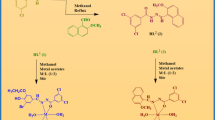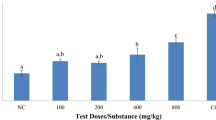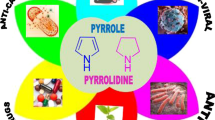Abstract
Background
The hydroxynaphthoquinones have been extensively investigated over the past 50 years for their anti-malarial activity. One member of this class, atovaquone, is combined with proguanil in Malarone®, an important drug for the treatment and prevention of malaria.
Methods
Anti-malarial activity was assessed in vitro for a series of 3-alkyl-2-hydroxy-1,4-naphthoquinones (N1-N5) evaluating the parasitaemia after 48 hours of incubation. Potential cytotoxicity in HEK293T cells was assessed using the MTT assay. Changes in mitochondrial membrane potential of Plasmodium were measured using the fluorescent dye Mitrotracker Red CMXROS.
Results
Four compounds demonstrated IC50s in the mid-micromolar range, and the most active compound, N3, had an IC50 of 443 nM. N3 disrupted mitochondrial membrane potential, and after 1 hour presented an IC50ΔΨmit of 16 μM. In an in vitro cytotoxicity assay using HEK 293T cells N3 demonstrated no cytotoxicity at concentrations up to 16 μM.
Conclusions
N3 was a potent inhibitor of mitochondrial electron transport, had nanomolar activity against cultured Plasmodium falciparum and showed minimal cytotoxicity. N3 may serve as a starting point for the design of new hydroxynaphthoquinone anti-malarials.
Similar content being viewed by others
Background
Despite the worldwide effort to understand molecular and cellular features of Plasmodium falciparum, the main aetiological agent of human malaria, the disease is still devastating. Parasite resistance to older anti-malarials raises the need for the development of new drugs [1, 2]. The anti-malarials currently used stem from six drug classes: aminoquinolines, arylaminoalcohols, artemisinins, antifolates, antibiotics and inhibitors of the respiratory chain [3, 4]. The last class is the subject of this report.
The hydroxynaphthoquinones have been extensively investigated over the past 50 years for their anti-malarial activity [5]. Hydrolapachol was the first hydroxynaphthoquinone discovered that possessed anti-malarial activity [6]. This discovery, which emerged at a time of great interest in the study of hydroxynaphthoquinone derivatives as potential new anti-malarials, resulted in the synthesis of a large family of different hydrolapachol analogs [7]. Work on the anti-malarial properties of hydroxynaphthoquinones was revived when chloroquine resistance emerged, and it was discovered that atovaquone effectively inhibits plasmodial electron transport at the ubiquinone (coenzyme Q, 2) site [8].
Atovaquone is a hydroxynaphthoquinone that is used in combination with proguanil (Malarone®) for prophylaxis and therapy of uncomplicated malaria [9]. Atovaquone has excellent anti-malarial activity but exhibits poor pharmaceutical properties, such as low bioavailability and high plasma protein binding [10]. To improve drug bioavailability, several atovaquone analogs were prepared and changes were made to the naphthoquinone moiety, especially the alkyl side chain, because it is known that modifying this chain can alter drug activity [7] and counteract drug resistance [11–13]. Recently, it was demonstrated that 2-methyl-heptyl or 2-methyl-heptyl-trifluoromethyl 2-hydroxy-1,4-naphthoquinones were highly effective against atova-quone-resistant P. falciparum[14].
The aim of this work was to test the activity of a new series of hydroxynaphthoquinones [15] against P. falciparum. One of these compounds, N3, had an IC50 against cultured P. falciparum in the nM range, disrupted mitochondrial membrane potential, and had low toxicity against human cells suggesting potential as a lead compound for the development of new anti-malarial agents.
Methods
Chemistry
The hydroxynaphthoquinones N1-5 were recently synthesized using a new methodology [15].
In vitro culture of P. falciparum
3D7 strain parasites were cultured and synchronized as described previously [16, 17]. Briefly, parasites were routinely maintained in A+ human erythrocytes (1-3% parasitaemia and 2% haematocrit) in RPMI-1640 media supplemented with 0.2% sodium bicarbonate, 50 mg/L hypoxanthine and 10% type A+ human serum in 92% N2, 5% CO2 and 3% O2.
Cell culture of HEK293T
HEK293T (human embryonic kidney) cells were cultured in 75 cm2 vented tissue culture flasks at 37°C in a humidified atmosphere containing 5% CO2 in Dulbecco’s modified essential medium (Gibco BRL) supplemented with 10% (v/v) foetal bovine serum, 100 U/ml penicillin/ and 100 μg/ml streptomycin.
Flow cytometry analysis
Infected erythrocytes at the ring stage were incubated with different concentrations of the test compounds (N1-N5 0.005, 0.015, 0.045, 0.137, 0.411, 1.23, 3.70, 11.11, 33.33 and 100 μM and atovaquone 0.005, 0.015, 0.045, 0.137, 0.411, 1.23, 3.70, 11.11, 33.33 and 100 nM) for 48 hours; fixed in 2% paraformaldehyde in phosphate-buffered saline (PBS) for 24 hours; permeabilized with 0.1% Triton X-100 and 20 μg/ml RNase; incubated for 30 minutes at 37°C; and stained with 1 nM Yoyo-1 (Molecular Probes). Parasitaemia was determined from dot plots (side scatter versus fluorescence) of 5x104 cells acquired on a FACSCalibur flow cytometer using CELLQUEST software (Becton Dickinson). Initial gating was carried out with unstained, uninfected erythrocytes to account for erythrocyte autofluorescence and analysis performed using Flow Jo 7.6.5 (TreeStar Inc).
Changes in mitochondrial membrane potential (ΨΔmit)
Loss of parasite mitochondrial membrane potential (ΨΔmit) was determined using 5 μM Mitrotracker Red CMXROS as described previously [18]. Cultures were incubated for 30 min at 37°C with the dye and then for 1 h with 10-fold serial dilutions (0.001-100 μM) of N3 and atovaquone. As a control, 5 μM cyanide m-chlorophenylhydrazone (CCCP), a protonophore that dissipate the membrane potential, was used. Results were analysed by flow cytometry as described above.
Cytotoxicity assays
The toxicity of hydroxynaphthoquinone derivatives toward HEK293T cells was evaluated with the 4,5-dimethylthiazol- 2-yl-2,5- diphenyltetrazolium bromide (MTT) cell proliferation assay [19]. Cells (1.0 × 105/well) were seeded into 48 well plates and incubated in complete medium (Dulbecco’s Modified Eagle Media, GIBCO, Life Technologies; supplemented with 10% foetal bovine serum, 100 μg/ml streptomycin and 100 U/ml penicillin) for 24 h. Thereafter, medium was removed and replaced with complete medium (450 μl/well); N3, atovaquone, and solvent (for controls) were added (0.128, 0.64, 3.2, 16, 80 and 400 μM) and cultures were incubated for 48 hours. Cells were then incubated with the MTT reagent for 3 hours, and absorbance was evaluated.
Statistical analyses
Analyses of parasitaemia were performed by a one-way analysis of variance test followed by post hoc analysis by the Dunnett’s Multiple Comparison Test using GraphPad Prism software. IC50 values were produced using sigmoid dose-response curves on GraphPad software. At least three independent experiments were performed for each assay.
Results
In vitro activity of new hydroxynaphthoquinones
The ability of compounds N1-N5 to disrupt the in vitro growth of P. falciparum was tested. The naphthoquinones showed activity against P. falciparum, with IC50s of 0.4-89 μM (Figure 1 and Additional file 1: Figure S1). Only N3 had an IC50 in the nM range (443 nM; Figure 2).
Cytotoxicity effects on cells HEK293T
Cytotoxic activity against HEK293T cells was assessed with a tetrazolium-based colorimetric assay. No significant cytotoxicity was observed at concentrations below 16 μM. For N3, the concentration leading to 50% cell death (CC50) was 54.6 ± 0.23 μM (Figure 1). For atovaquone the CC50 was 49 ± 0.45 μM.
Effect of N3 on ΔΨmit
It was also verified the effects of compound N3 on P. falciparum mitochondrial membrane potential (ΔΨmit). Compound N3 showed an IC50ΔΨmit = 16 μM and atovaquone an IC50ΔΨmit = 4.4 μM (Figure 3).
Proposed mechanism of action of N3. P. falciparum 3D7 was loaded with Mitotracker Red CMXROS and ∆ΨMit measured after 1-hour incubations at the indicated concentrations using flow cytometry. a) Effects of compounds (dashed lines) compared to untreated controls (solid lines): CCCP 5 μM; N3 100 μM and Atovaquone 100 μM. b) Dose responses of different concentrations of solvent control, atovaquone and N3 in the inhibition of ∆ΨMit. (*) indicates a statistically significant difference from control values (P < 0.05), data were compared using one-way ANOVA and Dunnett’s post test.
Discussion
In an attempt to identify improved anti-malarials, the anti-parasitic activities of synthetic hydroxynaphthoquinones using in vitro assays was evaluated. It was identified one compound, N3, with nanomolar activity against P. falciparum, confirmed activity against mitochondrial electron transport, and showed limited cytotoxicity against human cells.
The cytochrome bc1 complex catalyses transfer of electrons to maintain the membrane potential of mitochondria, and it is a validated target for anti-malarial drugs. Atovaquone is the only hydroxynaphthoquinone and inhibitor of the bc1 complex currently used to treat malaria. It is generally efficacious, but suffers from irregular absorption (improved with fatty food), limited drug resistance, and high cost of production [8, 9, 20]. Work to counteract atovaquone limitations has identified other hydroxynaphthoquinones with anti-malarial activity [8]. One series contained an ester at the 3-hydroxy group of atovaquone, with nanomolar anti-malarial activity; addition of long side chains decreased activity [11]. A series of 26 compounds based on the structure of rhinacanthin, a naphthoquinone with anticancer properties, was synthesized [21]; two of these had nanomolar activity and inhibited the cytochrome bc1 complex of P. falciparum. Another four hydroxynaphthoquinones were synthesized in an attempt to circumvent resistance to atovaquone, which is mediated by mutations in the mitochondrial cytochrome b gene [13]. The addition of a methyl radical on the naphthoquinone ring provided excellent activity against atovaquone-resistant strains of P. falciparum, with documentation of inhibition of the cytochrome bc1 complex [13]. It was recently screened 36 new anti-malarial phenylsulfanylmethyl naphthoquinones structurally related to lapachol [22]. The compounds had moderate in vitro activity against P. falciparum.
Comparing the structures of atovaquone, N3 and BW58-C (an atovaquone precursor), these three structures are very similar in molecular volume, though N3 is much simpler to prepare and has no chiral centers (Figure 4) and, therefore, it can serve as a starting point for a new series of hydroxynaphthoquinone anti-malarials. The results indicate that the cyclohexane ring of atovaquone is not essential for antimalarial activity, since its replacement by a CH2 group in N3 only slightly decreased activity, and N3 was capable of inhibiting mitochondrial activity efficiently (Figures 2 and 3). Considering BW58-C, this molecule showed excellent results against murine malaria [23] and good activity against respiration of mitochondria [24], but it was rapidly metabolized and eliminated in humans [25]. Interaction with cytochrome P450 enzymes and other aspects of metabolism are important components of drug design, and evaluation of the metabolism of N3 is needed.
Screening of a library of 2-hydroxy-naphthoquinones found compounds with alkyl side-chains that effectively inhibited the yeast b c1 complex [26]. In the present study, was evaluated 5 additional hydroxynaphthoquinones, and demonstrated that one of these, N3, was a potent inhibitor of mitochondrial electron transport, had nanomolar activity against cultured P. falciparum, and showed minimal cytotoxicity. Optimization of N3 thus offers potential for new candidate compounds to treat and prevent malaria.
References
Gazarini ML, Sigolo CA, Markus RP, Thomas AP, Garcia CR: Antimalarial drugs disrupt ion homeostasis in malarial parasites. Mem Inst Oswaldo Cruz. 2007, 102: 329-334. 10.1590/S0074-02762007000300012.
Garcia CR, de Azevedo MF, Wunderlich G, Budu A, Young JA, Bannister L: Plasmodium in the postgenomic era: new insights into the molecular cell biology of malaria parasites. Int Rev Cell Mol Biol. 2008, 266: 85-156.
Schlitzer M: Malaria chemotherapeutics part I: History of antimalarial drug development, currently used therapeutics, and drugs in clinical development. Chem Med Chem. 2007, 2: 944-986.
WHO: World Malaria Report. 2010, Geneva: World Health Organization
Srivastava IK, Rottenberg H, Vaidya AB: Atovaquone, a broad spectrum antiparasitic drug, collapses mitochondrial membrane potential in a malarial parasite. J Biol Chem. 1997, 272: 3961-3966. 10.1074/jbc.272.7.3961.
Hooker SC: Lomatiol. II. Its occurrence, constitution, relation to and conversion into lapachol. Also a synthesis of lapachol. J Am Chem Soc. 1936, 58: 1181-1190. 10.1021/ja01298a032.
Fieser LF, Berliner E, Bondhus FJ, Chang FC, Dauben WG, Ettlinger MG, Fields GFM, Fieser M, Heidelberger C, Heymann H, Seligman AM, Vaughan WR, Wilson AG, Wilson E, Wu M, Leffler MT, Hamlin KE, Hathaway RJ, Matson EJ, Moore EE, Moore MB, Rapala RT, Zaugg HE: Naphthoquinone antimalarials.4.5.6.7.8.9.10.11. synthesis. J Am Chem Soc. 1948, 70: 3174-3215. 10.1021/ja01190a004.
Barton V, Fisher N, Biagini GA, Ward SA, O’Neill PM: Inhibiting Plasmodium cytochrome bc1: a complex issue. Curr Opin Chem Biol. 2010, 14: 440-446. 10.1016/j.cbpa.2010.05.005.
Baggish AL, Hill DR: Antiparasitic agent atovaquone. Antimicrob Agents Chemother. 2002, 46: 1163-1173. 10.1128/AAC.46.5.1163-1173.2002.
Dressman JB, Reppas C: In vitro-in vivo correlations for lipophilic, poorly water-soluble drugs. Eur J Pharm Sci. 2000, 11 (Suppl 2): S73-S80.
Danoun S, Baziard-Mouysset G, Stigliani J, Ane-Margail M, Payard M, Leger J, Canron X, Vial H, Loiseau P, Bories C, Recoche C: Synthesis and protozoocidal activity of new 1,4-naphthoquinones. Heterocycl Comm. 1999, 5: 343-348.
El Hage S, Ane M, Stigliani J, Marjorie M, Vial H, Baziard-Mouysset G, Payard M: Synthesis and antimalarial activity of new atovaquone derivatives. Eur J Med Chem. 2009, 44: 4778-4782. 10.1016/j.ejmech.2009.07.021.
Hughes L, Lanteri C, O’Neil M, Johnson J, Gribble G, Trumpower B: Design of anti-parasitic and anti-fungal hydroxy-naphthoquinones that are less susceptible to drug resistance. Mol Biochem Parasitol. 2011, 177: 12-19. 10.1016/j.molbiopara.2011.01.002.
Hughes L, Covian R, Gribble G, Trumpower B: Probing binding determinants in center P of the cytochrome bc(1) complex using novel hydroxy-naphthoquinones. Biochim Biophys Acta. 2010, 1797: 38-43.
Ferreira S, da Rocha D, Carneiro J, Santos W, Ferreira V: A new method to prepare 3-Alkyl-2-hydroxy-1,4-naphthoquinones: synthesis of lapachol and phthiocol. Synlett. 2011, 2011: 1551-1554. 10.1055/s-0030-1260771.
Trager W, Jensen J: Human malaria parasites in continuous culture. Science. 1976, 193: 673-675. 10.1126/science.781840.
Lambros C, Vanderberg J: Synchronization of Plasmodium falciparum erythrocytic stages in culture. J Parasitol. 1979, 65: 418-420. 10.2307/3280287.
Jogdand PS, Singh SK, Christiansen M, Dziegiel MH, Singh S, Theisen M: Flow cytometric readout based on Mitotracker Red CMXRos staining of live asexual blood stage malarial parasites reliably assesses antibody dependent cellular inhibition. Malar J. 2012, 11: 235-10.1186/1475-2875-11-235.
Carmichael J, DeGraff WG, Gazdar AF, Minna JD, Mitchell JB: Evaluation of a tetrazolium-based semiautomated colorimetric assay: assessment of chemosensitivity testing. Cancer Res. 1987, 47: 936-942.
Kessl JJ, Meshnick SR, Trumpower BL: Modeling the molecular basis of atovaquone resistance in parasites and pathogenic fungi. Trends Parasitol. 2007, 23: 494-501. 10.1016/j.pt.2007.08.004.
Kongkathip N, Pradidphol N, Hasitapan K, Grigg R, Kao WC, Hunte C, Fisher N, Warman AJ, Biagini GA, Kongsaeree P, Chuawong P, Kongkathip B: Transforming rhinacanthin analogues from potent anticancer agents into potent antimalarial agents. J Med Chem. 2010, 53: 1211-1221. 10.1021/jm901545z.
Sharma A, Santos I, Gaur P, Ferreira V, Garcia C, Rochab D: Addition of thiols to o-quinone methide: New 2-hydroxy-3-phenylsulfanylmethyl [1,4]naphthoquinones and their activity against the human malaria parasite Plasmodium falciparum (3D7). Eur J Med Chem. 2013, 59: 48-53.
Hudson A, Randall A, Fry M, Ginger C, Hill B, Latter V, McHardy N, Williams R: Novel anti-malarial hydroxynaphthoquinones with potent broad spectrum anti-protozoal activity. Parasitology. 1985, 90: 45-55. 10.1017/S0031182000049003.
Hammond D, Burchell J, Pudney M: Inhibition of pyrimidine biosynthesis de novo in Plasmodium falciparum by 2-(4-t-butylcyclohexyl)-3-hydroxy-1,4-naphthoquinone in vitro. Mol Biochem Parasitol. 1985, 14: 97-109. 10.1016/0166-6851(85)90109-4.
Weaver R, Dickins M, Burke M: Cytochrome P450 2C9 is responsible for hydroxylation of the naphthoquinone antimalarial drug 58C80 in human liver. Biochem Pharmacol. 1993, 46: 1183-1197. 10.1016/0006-2952(93)90467-B.
Kessl JJ, Moskalev NV, Gribble GW, Nasr M, Meshnick SR, Trumpower BL: Parameters determining the relative efficacy of hydroxy-naphthoquinone inhibitors of the cytochrome bc1 complex. Biochim Biophys Acta. 2007, 1767: 319-326. 10.1016/j.bbabio.2007.02.014.
Acknowledgments
This work was supported by FAPESP (Fundação de Amparo a Pesquisa de São Paulo) (07/52924-0), by Malaria Pronex, and by a INCT-INBqMed (Instituto Nacional de Ciência e Tecnologia- Instituto Nacional de Ciência e Tecnologia de Biotecnologia Estrutural e Química Medicinal em Doenças Infecciosa) grant. C.R.S. Garcia and V. Ferreira are CNPQ (Conselho Nacional de Pesquisa) fellows. D.S. received a CAPES (Coordenação de Aperfeiçoamento de Pessoal de Nível Superior) Fellowship. D.R. da Rocha thanks FAPERJ (Fundação de Amparo a Pesquisa do Rio De Janeiro) for their doctoral fellowship. LNC and MM received a FAPESP Fellowship. Thanks are due to the CNPQ, CAPES and FAPERJ for funding this work.
Author information
Authors and Affiliations
Corresponding author
Additional information
Competing interests
The authors declare that they have no competing interests.
Authors’ contributions
DCS carried out the in vitro assays and drafted the manuscript. SBF and DRR carried out the chemical synthesis and collaborated in the elaboration of the manuscript. LNC and MN carried out the cytotoxicity test and collaborated in the elaboration of the manuscript. MN carried out the Plasmodium culture and collaborated in the elaboration of the manuscript. CRSG and VFF conceived of the study, and participated in its design and coordination and collaborated in the elaboration of the manuscript. All authors read and approved the final manuscript.
Electronic supplementary material
12936_2012_2865_MOESM1_ESM.docx
Additional file 1: Figure S1: Structures of other hydroxynaphthoquinones and effects on P. falciparum growth. Different concentrations of compounds were incubated for 48 h with P. falciparum. Results are shown as a dose response curve for compound N1, N2, N4 and N5 incubated for 48 h. Error bars represent standard error of the mean. (DOCX 75 KB)
Authors’ original submitted files for images
Below are the links to the authors’ original submitted files for images.
Rights and permissions
Open Access This article is published under license to BioMed Central Ltd. This is an Open Access article is distributed under the terms of the Creative Commons Attribution License ( https://creativecommons.org/licenses/by/2.0 ), which permits unrestricted use, distribution, and reproduction in any medium, provided the original work is properly cited.
About this article
Cite this article
Schuck, D.C., Ferreira, S.B., Cruz, L.N. et al. Biological evaluation of hydroxynaphthoquinones as anti-malarials. Malar J 12, 234 (2013). https://doi.org/10.1186/1475-2875-12-234
Received:
Accepted:
Published:
DOI: https://doi.org/10.1186/1475-2875-12-234








